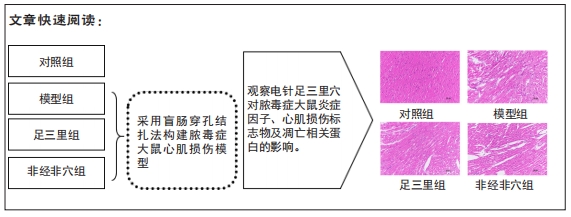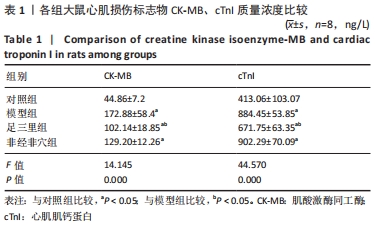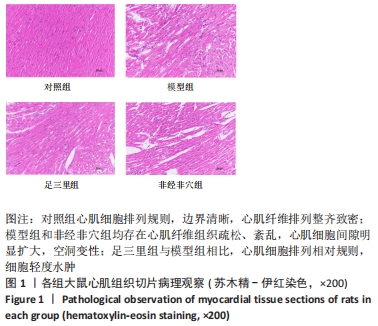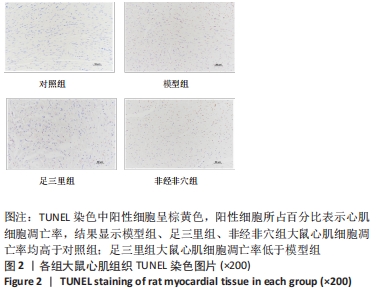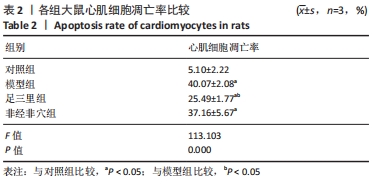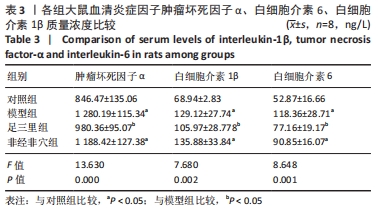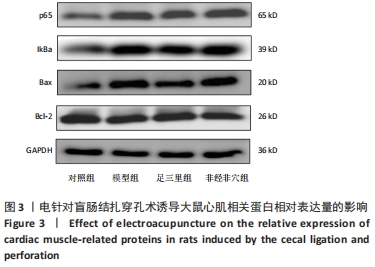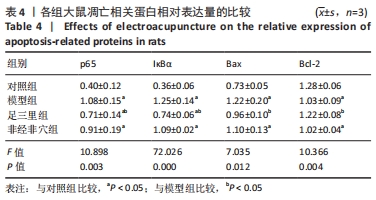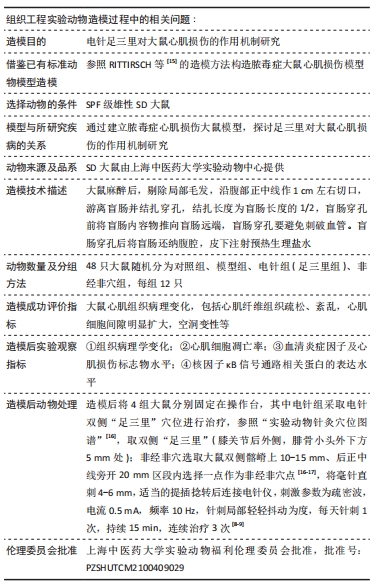[1] SINGER M, DEUTSCHMAN C, SEYMOUR C, et al. The Third International Consensus Definitions for Sepsis and Septic Shock (Sepsis-3). JAMA. 2016;315(8):801-810.
[2] KAHN J, LE T, ANGUS D, et al. The epidemiology of chronic critical illness in the United States. Crit Care Med. 2015;43(2):282-287.
[3] FLEISCHMANN C, SCHERAG A, ADHIKARI N, et al. Assessment of Global Incidence and Mortality of Hospital-treated Sepsis. Current Estimates and Limitations. American journal of respiratory and critical care medicine, 2016;193(3):259-272.
[4] HOCHSTADT A, MEROZ Y, LANDESBERG G. Myocardial dysfunction in severe sepsis and septic shock: more questions than answers? J Cardiothoracic Vasc Anesth. 2011;25(3):526-535.
[5] 关媛,黄志刚.常用心肌标志物在脓毒症早期心功能障碍中的诊断及预后评估[J].中国医药指南,2016,14(19):32-33.
[6] 钟建开.褪黑素通过Ripk3/线粒体通路改善脓毒症心肌功能障碍的机制研究[D].广州:南方医科大学,2020.
[7] 宁文华,李礼,郭扬,等.电针预处理脑保护作用机制研究进展[J].中国康复理论与实践,2019,25(11):1315-1319.
[8] 张帆.电针足三里对大鼠缺血再灌注损伤心肌的保护作用[D].长沙:中南大学,2009.
[9] LIU S, WANG ZF, SU YS, et al. Somatotopic Organization and Intensity Dependence in Driving Distinct NPY-Expressing Sympathetic Pathways by Electroacupuncture. Neuron. 2020;108(3):436-450.
[10] 赖芳.从胆碱能抗炎通路探讨电针足三里对脓毒症肺损伤的作用及机制[D].广州:广州中医药大学,2020.
[11] SONG Q, HU S, WANG HB, et al. Electroacupuncturing at Zusanli point (ST36) attenuates pro-inflammatory cytokine release and organ dysfunction by activating cholinergic anti-inflammatory pathway in rat with endotoxin challenge. Afr J Tradit Complement Altern Med. 2014;11(2):469-474.
[12] 张艳芳,余剑波.穴位刺激在脓毒症脏器损伤中的保护作用及机制[J].国际麻醉学与复苏杂志,2017,38(12):1143-1147.
[13] 曹好好,许美霞,李建国,等.电针刺激足三里穴对脓毒症大鼠心脏损害的保护作用[J].武汉大学学报(医学版),2016,37(1):38-41.
[14] CHAVAN SS, TRACEY KJ. Regulating innate immunity with dopamine and electroacupuncture. Nat Med. 2014;20(3):239-241.
[15] RITTIRSCH D, HUBER-LANG MS, FLIERL MA, et al. Immunodesign of experimental sepsis by cecal ligation and puncture. Nature Protocols. 2009;4(1):31-36.
[16] 林莺,纪峰,黄桂榕,等.针刺实验研究中大鼠非经非穴选取方法及思考[J].针刺研究,2013,38(4):334-338.
[17] SHIK YC, HYEOK-SANG J, HI-JOON P, et al. A proposed transpositional acupoint system in a mouse and rat model. Res Veter Sci. 2008;84(2): 159-165.
[18] 尉海涛.人参皂苷Rg1对糖尿病大鼠心肌损伤的保护作用及机制研究[D].长春:吉林大学,2016.
[19] 王东东,吴彦青,王晓鹏,等.脓毒症心肌损伤机制及中医药诊疗现状[J].北京中医药,2018,37(2):186-191.
[20] 江伟,杜斌.中国脓毒症流行病学现状[J].医学研究生学报,2019, 32(1):5-8.
[21] FLIERL MA, RITTIRSCH D, HUBER-LANG MS, et al. Molecular events in the cardiomyopathy of sepsis. Mol Med (Cambridge, Mass). 2008; 14(5-6): 327-336.
[22] 苏强,单秋华,孙令军,等.穴位特异性研究概况[J].山东中医杂志,2012,31(5):373-376.
[23] 华亮,陈泽斌.足三里、关元穴针刺预处理对老龄大鼠细胞免疫功能的影响[J].湖北中医杂志,2012,34(4):22-24.
[24] TORRES-ROSAS R, YEHIA G, PEñA G, et al. Dopamine mediates vagal modulation of the immune system by electroacupuncture. Nat Med. 2014;20(3):291-295.
[25] LIU S, WANG Z, SU Y, et al. A neuroanatomical basis for electroacupuncture to drive the vagal-adrenal axis. Nature. 2021; 598(7882):641-645.
[26] 邱荣宗.白藜芦醇对脓毒症NF-κB/IκB调节机制的研究[D].广州:广州医科大学,2017.
[27] PRABHU SD, FRANGOGIANNIS NG. The Biological Basis for Cardiac Repair After Myocardial Infarction: From Inflammation to Fibrosis. Circ Res. 2016;119(1):91-112.
[28] LEKKOU A, KARAKANTZA M, MOUZAKI A, et al. Cytokine production and monocyte HLA-DR expression as predictors of outcome for patients with community-acquired severe infections. Clin Diagn Lab Immunol. 2004;11(1):161-167.
[29] 胡丹丹,杨国良,楼黎明.盲肠结扎穿孔术法建立的脓毒症大鼠动物模型不同脏器组织超微结构动态变化观察[J].现代实用医学, 2016,28(10):1271-1273+1256.
[30] 姚苗苗,李永峰,金如玉,等.针刺论治原发性高血压病临床研究进展[J].陕西中医,2020,41(5):693-696.
[31] 董佳梓,薛亚楠,魏云涛,等.电针“足三里”对脾虚大鼠心肌细胞AMPK-线粒体通路的影响[J].北京中医药大学学报,2020,43(6): 522-528.
[32] 蔚鹏程,薛艳君,吴娇娟,等.电针太冲、足三里对自发性高血压大鼠心肌纤维化的改善作用[J].安徽中医药大学学报,2021,40(4): 64-68.
|
